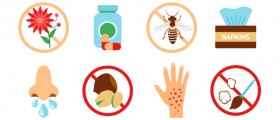Dairy allergy is one of many food allergies in which the immune system responds abnormally when exposed to certain proteins found in milk. This type of allergy is actually a reaction of hypersensitivity caused by an abnormal immunologic reaction. The body produces specific antibodies (IgE antibodies) and after repeated intake of dairy products a person develops different symptoms and signs of the allergic reaction.
It is essential to make a difference between intolerance to some foods and allergy. Intolerance is much more common and less serious comparing to allergy. The symptoms of the two conditions may resemble but only in case of food allergy one may develop a serious allergic reaction called anaphylaxis. Dairy allergy usually affects infants below the age of one. Still, this type of allergy may also develop later in life, even in adults. In many cases the allergy can be outgrown or the person remains allergic for the rest of his/her life.
What Causes Dairy Allergy?
As it is the case with any other allergy, a certain allergen triggers the reaction. In dairy allergy the person becomes hypersensitive to certain proteins that are normally found in dairy products. For example, a person may become allergic to casein or whey, both of which are components of milk. These substances are recognized by the immune system as 'foreign' and during the first intake of a dairy product the body produces specific antibodies. Repeated exposure to the specific protein induces the abnormal immunologic reaction and the person develops symptoms and signs of the allergic reaction.
Clinical Characteristics of Dairy Allergy
The symptoms and signs of dairy allergy range from mild to severe. In mild forms patients usually develop red and itchy skin rash and hives. More serious reactions include swelling of the lips, mouth, face and throat. Dairy allergy also leads to gastrointestinal symptoms and signs including nausea, vomiting, diarrhea, abdominal cramping and bloating. Sometimes the person may even develop respiratory symptoms and signs such as runny nose, nasal congestion, sneezing, coughing and wheezing. The most severe allergic reaction of dairy allergy is anaphylaxis.
Treatment for Dairy Allergy
In case of mild allergic reaction patients are prescribed with antihistamines. On the other hand, anaphylaxis represents an urgent condition and requires prompt medical attention and adequate treatment with several medications. In order to prevent repeated allergic reaction a person allergic to dairy products must avoid any kind of food that contains even traces of harmful proteins. Since dairy products contain calcium necessary for proper growth and development of the skeletal system and several more functions in the body the doctor will recommend suitable substitute source of calcium or prescribe supplements.

















Your thoughts on this
Loading...